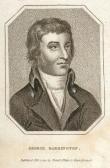George Barrington was a pickpocket who attained great fame in Britain at the end of the eighteenth century. He was notorious for his fashionable dress and gentlemanly manner, and gradually developed a reputation as a master thief (though many of his exploits were clearly exaggerated by the press). His background is unclear - two biographies published at the peak of his fame in 1790 give very different accounts of his upbringing - but he was clearly a man of some education. His eloquent trial defences helped him avoid conviction on several occasions, and were widely reported in contemporary newspapers. He was transported to New South Wales in 1791, where his abilities saw the colonial government appoint him as high constable at the settlement at Toongabbie. Barrington received a conditional pardon in 1792, and an absolute pardon in 1796, by which stage he was superintendent of convicts at Parramatta with an annual salary from the crown. Illness forced Barrington's retirement in 1800, and he died in 1804, described by the Sydney Gazette as 'a lunatic'.
In 1795, an enterprising London bookseller cashed in on Barrington's fame and the interest in the fledgling colony of New South Wales (and probably also the news of Barrington's metamorphosis into authority figure) by producing a book entitled A Voyage to New South Wales, which was allonymously attributed to Barrington. In reality, this work was a plagiarised reworking of the published journals of other colonial officers. Nonetheless, it was very successful and numerous editions were produced, including translations into French, Russian, Spanish and Swedish. Further 'George Barrington' works followed. The actual Barrington had nothing to do with any of them, however, and another ex-convict official recalled that Barrington:
expressed a very considerable degree of displeasure, when he was in a state of sanity, at his name being affixed to a narrative, which he knew only by report, as being about to be published, and which subsequently did appear, under a deceptious mask (D. D. Mann, The Present Picture of New South Wales (London: John Booth, 1811), p. 31).
 6130367542109961769.jpg
6130367542109961769.jpg